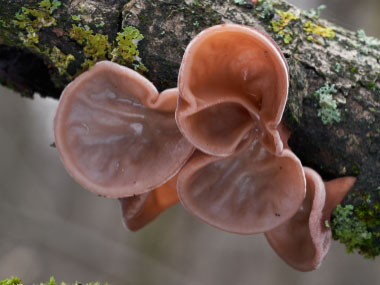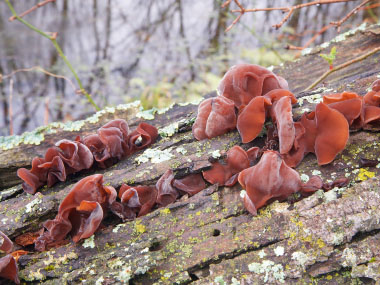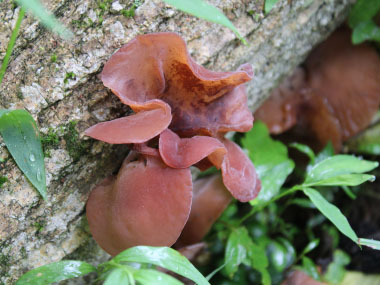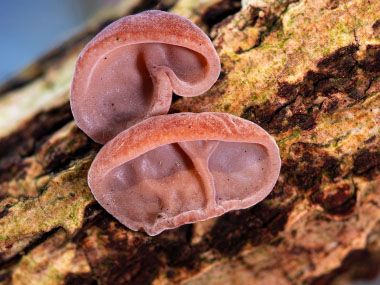





Do not eat any fungi that has not been properly identified by a qualified professional, some are DEADLY when ingested. All edible wild fungi MUST be cooked.
Jelly ear mushrooms are an edible jelly fungus that is a member of the Auriculariaceae family. This commonly found jelly mushroom is also known as cloud ear, tree ear, black fungus, and wood ear. Although there are a few other jelly mushrooms that share the same common name, always go by the botanical name for proper identification. This jelly fungi has been cultivated for food in China for centuries. When dried, it loses its rubbery quality and turns black. Interestingly, Auricularia means ear in Latin. And, for this species, auricula-judae translates to Judas’s ear (a bible reference).
Type
Distinguishing Features
Jelly ear flesh is dense to thin and mostly translucent, depending on maturity. The outer surface of the lobed fruitbody is tan-brown with a purple tinge and covered in a fine greyish velvety down. Sometimes they can take on a somewhat pinkish hue. The inner surface is smooth. The fruiting body often resembles a human ear growing out of a tree and has a very rubbery texture. Sometimes, they have a few exterior and interior wrinkles or veins, while other times, the inner portion is made up of many folds that are difficult to distinguish. When they grow close together, the folds of one often merge into another, creating a large grouping of irregularly shaped ears.
Height
These grow low to the wood but individual lobes of grow to between 3 and 10cm (1 to 4”) across.
Habitat
Jelly ears are found predominately on dead or dying elder trees, but they have also been found on dead and living trees such as ash, spindle, ash, and beech. In Australia they can be found on dead eucalyptus branches.
Spore Print
White.
Season
Jelly ear mushrooms prefer cool weather. They thrive in temperatures below 15 degrees C (60 degrees F) and will survive frosts. In northern climates, they are found in early spring and again in late autumn and even early winter. They may be found throughout the winter in southern climates as the temperatures never get low enough to discourage their growth.
Gills
No gills.
Edibility
Jelly ear mushrooms are best suited for cooked applications such as boiling, stir-frying, and sautéing. Before cooking, any tough patches should be removed. Used for their texture, they can be added to soups or stir-fries and readily absorb accompanying flavors. On their own, there is no real flavor. These are a significant source of vitamin B5 and copper, with smaller amounts of selenium and vitamin B2.
Other Name
Wood Ear Jelly.
Recipes
To support our efforts please browse our store (books with medicinal info, etc.).
Winter Survival Food Handbook

PDF Plant Magazines
Types of Wild Food
Geographic Zones Seasons
Disclaimer
EdibleWildFood.com is informational in nature. While we strive to be 100% accurate, it is solely up to the reader to ensure proper plant identification. Some wild plants are poisonous or can have serious adverse health effects.
We are not health professionals, medical doctors, nor are we nutritionists. It is up to the reader to verify nutritional information and health benefits with qualified professionals for all edible plants listed in this web site. Please click here for more information.
Why Edible Wild Food?
- Food costs are rising
- Free, wild food is readily abundant
- Wild food adds nutrition to your diet
- Wild food can help treat various medical conditions





